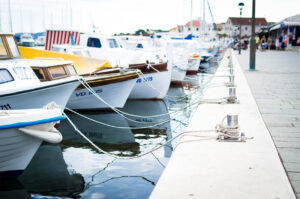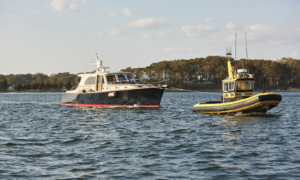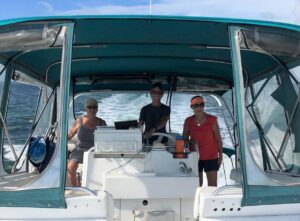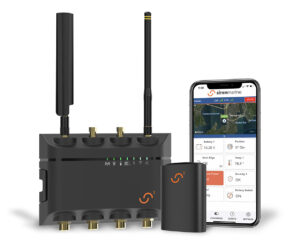The call coming over the VHF radio was normal because boats following another in the Intracoastal Waterway (ICW) often request permission to pass along narrow stretches. Joyce and Dave were used to being passed after years of traveling the ICW in their slow trawler. However, Joyce was not expecting the boat trailing them that morning to ask if they had a dog on board.
She answered, “Yes, we have two.” The boat then asked if one possibly fell overboard. Joyce responded no, because their trawler had tall sides that the dogs couldn’t jump over. Joyce called out to Piper and Maggie, their two golden retrievers, to make sure, but only Maggie came into the pilot house wagging her tail. The boat then radioed that a golden retriever was swimming toward it. Joyce dashed around looking for Piper, disbelieving he had tumbled overboard, but the pup was nowhere to be found. Fortunately, this story has a happy ending. The boat following Joyce and Dave that day pulled Piper from the water and reunited the couple with their pet at a nearby marina.
Boaters frequently hear stories of people or dogs falling overboard, but no one believes it could happen to them. Take the story of John Aldridge, a professional lobsterman with years of nautical experience. It only took the simple act of trying to move a heavy cooler when the handle broke, he lost his balance and suddenly found himself in the water, watching his boat and sleeping partner slowly leave him in the cold dark Atlantic Ocean. Fortunately, the Coast Guard located John the next day after he spent the night floating on his overturned rubber boots and a large lobster buoy.
A primary skill in all boating courses is learning how to handle a man overboard (MOB) situation. We need to know how to turn a boat as quickly as possible to return along the same course line and why it is someone’s sole job to keep an eye on the person in the water. Most GPS chart plotters have a MOB feature that allows you to fix a position on the GPS screen at the point where someone goes overboard. That’s very useful information, but it makes a dangerous assumption that someone knows a crew mate has fallen overboard. All too often, as in the two examples above, those on the boat are not aware someone had fallen into the water.
Quickly locating and bringing someone back aboard is the surest way to rescue a crew member. Emergency Position Indicating Radio Beacons (EPIRBs) and Personal Locator Beacons (PLBs) are the gold standard for alerting search and rescue personal of someone in distress.
Transmitting to an international array of satellites, these devices activate a response network of government organizations to initiate a rescue. While highly valuable to many types of boating, these devices do not alert boaters that someone has fallen overboard.
PERSONAL AIS BEACONS
Another category of devices was invented recently to serve this important role. Using radio frequencies, these devices activate on-board equipment that alerts a crew that someone is in the water or is separated from the boat. The devices fall into two categories: those with Automatic Identification Systems (AIS) and others with an electronic tether between a base station and individual monitors.
AIS has grown into a wonderful safety feature. It was originally designed as an accident-avoidance tool for commercial vessels, but electronic equipment manufacturers and recreational boaters quickly adapted it to their use. By transmitting a packet of information with the boat’s name and movement over VHF radio frequencies, boaters equipped with AIS transmitters and receivers see exact boat activity around them.
This technology has now been adapted into MOB devices. Personal AIS MOB beacons operate on the AIS system. Small AIS beacons are designed to wear on an inflatable personal flotation device (PFD). When the PFD inflates, the unit opens an antenna and begins transmitting a unique MOB identifier. This signal is received and sounds an alarm on all boats within a three- to five-mile range with an AIS receiver, thereby increasing the number of boats aware a person is in the water and the chance of a speedy rescue.
Some AIS personal beacons also broadcast an alert over the VHF DSC (digital select calling) system. While extremely helpful and dependable, AIS personal beacons only alert and guide vessels to a person in the water if the boat is equipped with an AIS receiver. Those with the DSC feature notify all VHF radios in range of a person in the water. A built-in GPS broadcasts latitude and longitude coordinates with the DSC signal.
TETHERED UNITS
Realizing not all boats have or need an AIS, the second category of units that work on the electronic tether principal are suitable for all vessels and can have other valuable functions. Some models use a smart phone or tablet application along with a low-energy reliable Bluetooth link to monitor individual MOB devices. If the devises lose contact with the phone app or if the units become submerged in water, the app sounds an alarm indicating a man overboard. Using the phone’s internal GPS and compass, the app directs the boat back to the separation point.
Be sure to note, these units do not use Bluetooth to locate the lost device. This is done solely with a smart phone’s GPS and compass. By continuously monitoring individual MOB devices, these systems repeatedly run tests for connectivity. The apps can monitor up to five MOB devices simultaneously, making them suitable for crew, pets or even a dinghy being towed. With the water activated feature, some are even suitable to use as a bilge high- water alarm.
LIFESAVING
The absolute best way to keep your crew safe is keeping them in the boat from the beginning. Review man overboard and safe practices specific to your boat with family and friends each time you go out. Make sure all boarding gates and lifelines are securely closed or latched. Insist everyone moving around an exterior open deck area of the boat is wearing a life preserver and where necessary secured to the vessel with a lifeline. Make sure swim ladders are easy to deploy, especially by a person in the water.
We do everything possible to prevent fires aboard, but we still carry fire extinguishers. We go to great lengths to keep water out, but our boats still have bilge pumps. Do everything you can to keep passengers in the boat, but please utilize a man overboard device for everyone on board as well.





